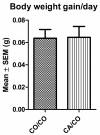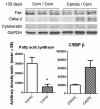Maternal consumption of canola oil suppressed mammary gland tumorigenesis in C3(1) TAg mice offspring
- PMID: 20205934
- PMCID: PMC2846884
- DOI: 10.1186/1471-2407-10-81
Maternal consumption of canola oil suppressed mammary gland tumorigenesis in C3(1) TAg mice offspring
Abstract
Background: Maternal consumption of a diet high in omega 6 polyunsaturated fats (n-6 PUFA) has been shown to increase risk whereas a diet high in omega 3 polyunsaturated fats (n-3 PUFA) from fish oil has been shown to decrease risk for mammary gland cancer in female offspring of rats. The aim of this study was to determine whether increasing n-3 PUFA and reducing n-6 PUFA by using canola oil instead of corn oil in the maternal diet might reduce the risk for breast cancer in female offspring.
Methods: Female SV 129 mice were divided into two groups and placed on diets containing either 10% w/w corn oil (which is 50% n-6 PUFA, control diet) or 10% w/w canola oil (which is 20% n-6 PUFA, 10% n-3 PUFA, test diet). After two weeks on the diets the females were bred with homozygous C3(1) TAg transgenic mice. Mother mice consumed the assigned diet throughout gestation and nursing of the offspring. After weaning, all female offspring were maintained on the control diet.
Results: Compared to offspring of mothers fed the corn oil diet (CO/CO group), offspring of mothers fed the canola oil diet (CA/CO group) had significantly fewer mammary glands with tumors throughout the experiment. At 130 days of age, the CA/CO group had significantly fewer tumors per mouse (multiplicity); the tumor incidence (fraction of mice with any tumor) and the total tumor weight (per mouse that developed tumor) was less than one half that of the CO/CO group. At 170 days of age, the total tumor weight per mouse was significantly less in the CA/CO group and if a tumor developed the rate of tumor growth rate was half that of CO/CO group. These results indicate that maternal consumption of canola oil was associated with delayed appearance of mammary gland tumors and slowed growth of the tumors that developed.
Conclusions: Substituting canola oil for corn oil is an easy dietary change for people to make; such a change to the maternal diet may decrease risk for breast cancer in the daughter.
Figures





References
-
- Rose DP. Dietary fatty acids and prevention of hormone-responsive cancer. Proc Soc Exp Biol Med. 1997;216:224–233. - PubMed
-
- Hilakivi-Clarke L, Clarke R, Onojafe I, Raygada M, Cho E, Lippman M. A maternal diet high in n-6 polyunsaturated fats alters mammary gland development, puberty onset, and breast cancer risk among female rat offspring. Proc Natl Acad Sci USA. 1997;94:9372–9377. doi: 10.1073/pnas.94.17.9372. - DOI - PMC - PubMed
Publication types
MeSH terms
Substances
Grants and funding
LinkOut - more resources
Full Text Sources
Miscellaneous

